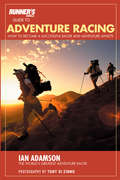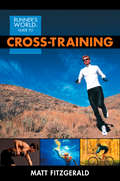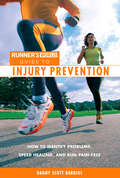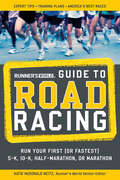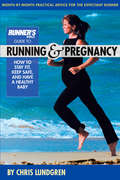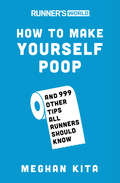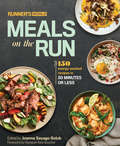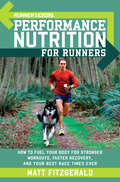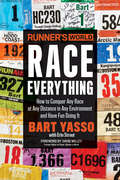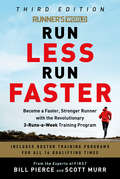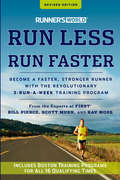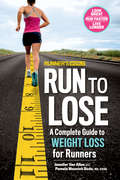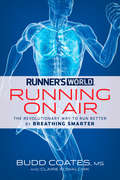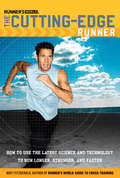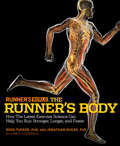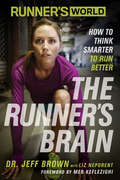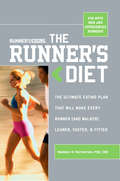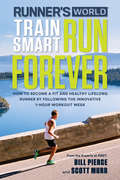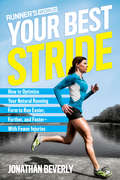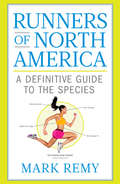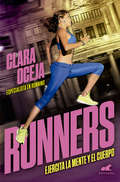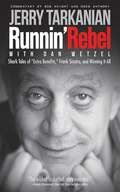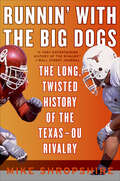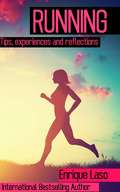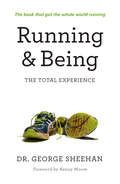- Table View
- List View
Runner's World Guide to Adventure Racing: How to Become a Successful Racer and Adventure Athlete (Runner's World)
by Ian AdamsonHow to Become a Successful Racer and Adventure Athlete Why should you take a pair of sandals, a dollar bill, and a car antenna to your next adventure race? You'll find the answer to that question and many others in Runner's World Guide to Adventure Racing. In this authoritative guide, Ian Adamson shares his insider secrets for training, racing, team building, conflict management, injury prevention, equipment repair, sleep management, and much more. Often referred to as the Michael Jordan of adventure racing, Adamson helps you navigate any type of adventure race, from short sprint race to full-length expedition. In this guide, you'll find: - Detailed training plans for recreational and competitive athletes - Tips for running, hiking, biking, paddling, navigating, and climbing more efficiently - A no-nonsense guide for what you need from the sporting goods store--and what you don't - Insider secrets for mending equipment and injuries while in the wilderness - Adamson's nine favorite foods to pack in your race bag You'll also read Adamson's humorous, touching, and downright chilling stories of life on the adventure trail. From sprint races to full-length expeditions, Adamson's expert advice will get you and your equipment to the finish line in one piece.
Runner's World Guide to Cross-Training: How To Cross-train To Improve Running Times And Prevent Injuries (Runner's World)
by Matt FitzgeraldHow to cross-train to improve running times and prevent overuse injuries--whether you are participating in your first 10-K or competing to win a marathon or triathlon If you want to enjoy a long, successful life of running, it's essential to incorporate non-running activities into your training program.Strength exercises will keep your muscles in balance. Flexibility exercises will keep them supple. And alternative endurance activities will help heal existing injuries while preventing future ones.In Runner's World Guide to Cross-Training, Matt Fitzgerald--seasoned runner, triathlete, sports and fitness journalist, and online coach to runners and triathletes--tells you everything you need to know about the very best cross-training exercises for runners, from the equipment you'll have to buy to the techniques you'll have to master. In addition to strength training and flexibility exercises, he recommends the six best non-impact cardiovascular activities for runners: pool running, elliptical training, bicycling, inline skating, swimming, and cross-country skiing. The book shows how to integrate running and cross-training, and features five complete sample programs that will train you to compete in a basic 10-K, advanced 10-K/half marathon, basic marathon, advanced marathon, and triathlon. Until now, there hasn't been a credible cross-training book designed especially for runners. With the imprimatur of Runner's World magazine-recognized everywhere as the most authoritative source of information on the sport-this excellent guide will be welcomed by runners at every level as the book to consult for advice on this vital topic.
Runner's World Guide to Injury Prevention: How to Identify Problems, Speed Healing, and Run Pain-Free (Runner's World)
by Dagny Scott BarriosThe last word on preventing and treating running injuries-from the magazine known the world over as the most reliable and authoritative source of running know-howThe world of running-and running injury prevention-has evolved greatly in the last decade. New thinking on injury and recovery suggests that runners can continue to train while injured. And alternative practices-such as acupuncture, chiropractic, and massage-are now virtually mainstream and an essential part of any runner's injury arsenal. Not only is the sport dramatically more popular, but women runners and beginning runners-who are a large part of the growth-have very different needs in the areas of injury and health that have not been covered adequately in previous books. Research in sports medicine also has advanced. All this-and much more--is covered in Runner's World Guide to Injury Prevention, making it the best, most authoritative guide in the field. Here you'll find: - The most important stretches for runners-and why you should not stretch an injured muscle- How (and why) to change your biomechanics and stride length- How to incorporate cross-training to prevent and heal injury - The most important strength-training exercises for runners- How to cope with the mental side of injury- Special concerns for young runners, women, and older Runners- The newest thinking in hydrationBeginners and veterans alike will benefit from this expert guidance from the cutting edge of sports medicine and science.
Runner's World Guide to Road Racing: Run Your First (or Fastest) 5-K, 10-K, Half-Marathon, or Marathon (Runner's World)
by Katie Mcdonald NeitzRunner's World senior editor Katie Neitz has compiled the best tips and techniques on training, pace, nutrition, injury rehabilitation and prevention, and every other detail that will lead to peak performance. In sections devoted to each of the four races, Runner's World Guide to Road Racing lays out the insider secrets of the pros in concise, user-friendly format, including: - Distance-specific training programs - Eating plans - Tips for hydration - Race-day strategies - Pacing recommendations - Advice on achieving the optimal mental state for competition Providing level-specific techniques and strategies for beginner, intermediate, and advanced runners, both competitive and recreational, this is a no-nonsense, fluff-free guide that will quickly become the road racer's bible.
Runner's World Guide to Running and Pregnancy: How to Stay Fit, Keep Safe, and Have a Healthy Baby (Runner's World)
by Chris LundgrenEach year, about 785,000 women runners who are pregnant or who have recently given birth hear conflicting fitness advice from friends, family, and even doctors. Save for a handful of magazine articles, these women have nowhere to turn for accurate, up-to-date information.Until now. The Runner's World Guide to Running and Pregnancy is a first-of-its-kind, comprehensive look at the how-tos and benefits of running for expectant mothers. And the benefits abound. Even a modest pregnancy running program gives women a reduced risk of gestational diabetes, high blood pressure, and premature birth. It also leads to fewer cesareans, faster recovery after delivery, and even smarter babies!From the worldwide authority on running, the Runner's World Guide to Running and Pregnancy offers the latest, most detailed information available, along with real-life tips to help you succeed. Inside you'll find:- Advice from experts including sports gynecologists, nutritionists, and exercise physiologists- The most current heart rate and training guidelines- Pre-pregnancy and pregnancy stretching and strength programs- Cross-training suggestions including yoga, Pilates, swimming, and more- Running-specific menu plans for a healthy pregnancy- Strategies for preventing injuries- Money-saving tips for choosing the best maternity running gear- Guidance for postpartum runningThe Runner's World Guide to Running and Pregnancy gets to the bottom of the how-much-is-too-much debate once and for all. Pregnant runners will never be puzzled by conflicting advice again.
Runner's World How to Make Yourself Poop: And 999 Other Tips All Runners Should Know (Runner's World)
by Meghan KitaEvery runner knows how important it is to clear out before you head out—and Runner’s World How to Make Yourself Poop shows you how.With tips on training, nutrition, gear, motivation, health, and racing delivered with humor and clarity, this book is essential reading for any runner who wants to improve your performance. From "The Best Way to Tie Your Shoes” to “3 Ways to Make Yourself Poop” and everything in between, these short, easy-to-use tips from reliable experts will benefit any runner.
Runner's World Meals on the Run: 150 energy-packed recipes in 30 minutes or less (Runner's World)
by Joanna Sayago GolubWhile all runners need to eat well to fuel their performance, most don’t have the time to cook complex or labor-intensive meals to meet their unique nutritional needs. But if you’ve got 30 minutes, you can prepare fresh, delicious meals that will bolster your running and satisfy your appetite. Meals on the Run includes more than 150 healthy, energy-packed recipes that can all be prepared in small windows of time—some in 10 minutes or less! From simple snacks and smoothies to weeknight dinners, you’ll find everything you need to get high-quality food on the table fast. If you follow a specialized diet—vegetarian, vegan, low-calorie, or gluten-free—or need your meals to match your training plan, each recipe is marked so you can easily see if a particular recipe fits your needs. Every delicious, healthy recipe in Meals on the Run features fresh, minimally processed ingredients that offer superior nutrition and taste. Once you get cooking, you’ll find that fast meals can be synonymous with good taste, good health, and good running.
Runner's World Performance Nutrition for Runners: How to Fuel Your Body for Stronger Workouts, Faster Recovery, and Your Best Race Times Ever (Runner's World)
by Matt FitzgeraldUp-to-date nutrition advice for runners, based on the latest scienceRunners have different nutrition and recovery needs than other endurance athletes. Yet until now, they've had no nutritional resource specifically addressing their concerns.This comprehensive guide distills the newest thinking in the science of exercise nutrition into practical, hands-on tips that will help runners stay healthy, recover faster, enjoy better workouts, and race successfully. Readers will learn:• detailed information on nutritional topics important to runners, from balancing internal energy stores to proper hydration• how to customize their diets to their individual training needs• shopping tips and dining-out strategies to help runners maximize their nutritional intake• the top 5 pre-race meals and top 5 healthiest snacks for runners• nutritional tips for special populations, including women, children, diabetics, and older runners
Runner's World Race Everything: How to Conquer Any Race at Any Distance in Any Environment and Have Fun Doing It (Runner's World)
by Bart Yasso Erin StroutHow to be prepared no matter where running might take youMillions of runners around the US are interested in special experiences, whether it means running a bucket-list event like the Boston Marathon, or competing in beautiful and challenging locales such as Rome or Death Valley. Whatever race you choose, there is no one better to guide you on your journey than Bart Yasso, chief running officer at Runner’s World magazine. Over the past 40 years, Yasso has run more than 1,000 races, across all seven continents, at every conceivable distance, from local 5Ks to grueling ultramarathons and Ironman triathlons. He’s truly done it all, and in Race Everything, he shares the secrets of how he trained, the particularities of each course, and the specific insights he has gleaned to help you run your best no matter the distance.This book offers tried-and-true advice on how to train and what to do on race day to make the best use of your training. It provides everything you need to know to succeed at the most popular race distances, including general training principles, targeted training plans for beginners and experienced runners alike, and insider tips based on Yasso’s own experiences and those of other top runners he has known and run with. The goal is to inform and inspire runners eager to challenge themselves by tackling the world’s signature races. You will also learn Yasso’s methods for winning the greatest race of all, longevity, so that you can remain healthy, fit, and able to race for decades to come.Whether your goal is to complete a 5K or 10K race in your hometown or conquer the Antarctica Marathon, Runner's World Race Everything will be your guide.
Runner's World Run Less Run Faster: Become a Faster, Stronger Runner with the Revolutionary 3-Runs-a-Week Training Program (Runner's World Ser.)
by Bill Pierce Scott MurrFinally, runners at all levels can improve their race times while training less, with the revolutionary Furman Institute of Running and Scientific Training (FIRST) program.Hailed by the Wall Street Journal and featured twice in six months in cover stories in Runner's World magazine, FIRST's unique training philosophy makes running easier and more accessible, limits overtraining and burnout, and substantially cuts the risk of injury, while producing faster race times.The key feature is the "3 plus 2" program, which each week consists of:-3 quality runs, including track repeats, the tempo run, and the long run, which are designed to work together to improve endurance, lactate-threshold running pace, and leg speed-2 aerobic cross-training workouts, such as swimming, rowing, or pedaling a stationary bike, which are designed to improve endurance while helping to avoid burnoutWith detailed training plans for 5K, 10K, half marathon, and marathon, plus tips for goal-setting, rest, recovery, injury rehab and prevention, strength training, and nutrition, this program will change the way runners think about and train for competitive races.Amby Burfoot, Runner's World executive editor and Boston Marathon winner, calls the FIRST training program "the most detailed, well-organized, and scientific training program for runners that I have ever seen."
Runner's World Run Less, Run Faster: Become a Faster, Stronger Runner with the Revolutionary 3-Run-a-Week Training Pr ogram (Runner's World)
by Bill Pierce Scott Muhr Ray MossThe Furman Institute of Running and Scientific Training (known as FIRST) is dedicated to make running more accessible and limit overtraining and burnout while producing faster race times. FIRST is one of the foremost experts in the world on the science of running; its authority is unmatched and the promise of training less and accomplishing more has made the first two editions of Run Less, Run Faster a solid and steady seller. With 50 percent updated content, this new edition of Runner's World Run Less, Run Faster by Bill Pierce, Scott Murr, and Ray Moss continues to promise the same tantalizing results: Readers can get stronger, faster, and better by training less. It will also include more sections for novice runners, broadening the audience appeal, as well as training plans tailored to the new qualifying times for the Boston Marathon. The quality-over-quantity approach optimizes training time and yields better performance—results runners will love no matter what distance they are racing.
Runner's World Run to Lose: A Complete Guide to Weight Loss for Runners (Runner's World)
by Jennifer Van Allen Pamela Nisevich BedeDrop unwanted pounds and keep them off for good with Runner’s World Run to Lose, your comprehensive guide to weight loss from the experts at Runner’s World. Running is proven to be one of the most effective, cost-efficient, and accessible weight-loss strategies. Weight loss and running are not one-size-fits-all, and Run to Lose provides everything you need to customize a unique diet and running program that works for you. Certified running coach Jennifer Van Allen and sports nutritionist Pamela Nisevich Bede show you how to incorporate running into an individualized nutrition and fitness program that will maximize your weight-loss results while improving your athletic performance. Whether you are a seasoned marathoner looking to shave minutes by shedding a few pounds or a beginning runner lacing up for the very first time, Run to Lose provides you with the tools and information you need to get started and stay on track. This book is full of guidance on tricky topics such as how to balance your weight-loss goals while consuming enough nutrients to power your workouts; how to maximize your calorie burn; the best high-quality/low-calorie carbs to fuel your run; and advice on how to avoid common diet pitfalls. Complete with easy-to-follow training guides and detailed meal plans, Run to Lose will help you shape up, get stronger, and achieve your fitness goals.
Runner's World Running on Air: The Revolutionary Way to Run Better by Breathing Smarter (Runner's World)
by Claire Kowalchik Budd CoatesRenowned running coach Budd Coates presents Runner's World Running on Air, a revolutionary yet simple training method based on rhythmic breathing to help runners at all experience levels improve their performance, prevent injury, and experience the joy of running. Validating his method through a mix of accessible science, Eastern philosophy, and the experiences of test subjects, Coates shows readers how focusing on their breathing brings their minds and bodies into harmony and helps them run stronger, faster, and more comfortably.Rhythmic breathing increases lung volume; improves awareness and control; helps prevent injury and side stitches; improves running for those with asthma; allows runners to quickly set a pace for quality training and racing; and helps athletes manage muscle cramps. This book reviews the basics of rhythmic breathing, teaching readers how to perform it while walking and, eventually, while running. Weeklong sample schedules from different programs shows readers how to apply the rhythmic breathing scale to any workout. Coates also touches on the importance of stretching, cross-training, and core training and provides detailed training plans and schedules.
Runner's World The Cutting-Edge Runner: How to Use the Latest Science and Technology to Run Longer, Stronger, and Faster (Runner's World)
by Matt FitzgeraldA state-of-the-science resource for runners--with the latest information on training, nutrition, injury prevention, and gear and gadgets that improve performance.The science and technology of running have evolved dramatically in the past 20 years. This all-inclusive resource--based on the author's own high-level running and coaching experience and his interviews with dozens of other top runners and coaches--is an indispensable tool for runners who hope to perform at the very best of their ability.Runner's World The Cutting-Edge Runner provides: • A comprehensive overview of how the best competitive runners train today--covering such topics as periodization, physiological testing, group training, technique work, cross-training, recovery techniques, and individual customization • In-depth discussions of equipment and other technologies that can benefit the runner, including shoes, orthotics, heart rate monitors, altitude tents, training software, and more • A complete "menu" of workouts for milers to marathoners Whether he is explaining how to use hypoxic conditioning to increase oxygen consumption capacity, telling how to prepare for the mental challenge of racing, or detailing what the latest science has to say about the pros, cons, and proper usage of more than 15 nutritional supplements and drugs, Matt Fitzgerald goes straight to the most authoritative sources and provides practical ways for the average runner to adapt methods and tools used by top runners to their own running programs.
Runner's World The Runner's Body: How the Latest Exercise Science Can Help You Run Stronger, Longer, and Faster (Runner's World)
by Matt Fitzgerald Ross Tucker Jonathan DugasEvery day scientists learn more about how the body adapts to the stress of running—and how various body systems contribute to running performance. Leading the charge is a fresh generation of brilliant young exercise physiologists including Ross Tucker and Jonathan Dugas, whose work has demolished many long-standing beliefs about running. Now Tucker and Dugas, whose blog, Science of Sport, has already created a devoted readership, join with esteemed fitness author Matt Fitzgerald to provide a captivating tour of the human body from the runner's perspective. Focusing on how runners at all levels can improve their health and performance, Runner's World The Runner's Body offers in a friendly, accessible tone, the newest, most surprising, and most helpful scientific discoveries about every aspect of the sport—from how best to nourish the runner's body to safe and legal ways to increase oxygen delivery to the muscles. Full of surprising facts, practical sidebars, and graphical elements, The Runner's Body is a must-have resource for anyone who wants to become a better—and healthier—runner.
Runner's World The Runner's Brain: How to Think Smarter to Run Better (Runner's World)
by Jeff Brown Liz NeporentAs a runner, your biggest asset (or sometimes your greatest enemy) is your brain. What you think and feel on and off the road also has a huge influence over how you perform once you lace up. Runner's World The Runner's Brain shows you how to unlock and capture the miraculous potential of the body's most mysterious and intriguing organ and rewire your mind for a lifetime of athletic success. The book is based on cutting-edge brain science and sports psychology that author Dr. Jeff Brown uses every day in his private practice and as part of the medical team of several major road races including the Boston Marathon. Full of fascinating insights from runners of all abilities-including champion marathoner Meb Keflezighi and other greats-the book includes trustworthy information that's been proven to work both in the lab and on the road.
Runner's World The Runner's Diet: The Ultimate Eating Plan That Will Make Every Runner (and Walker) Leaner, Faster , and Fitter (Runner's World)
by Madelyn H. FernstromA unique eating plan for both novice and experienced runners--to help you achieve optimum performance and keep those unwanted pounds off.If you are a serious runner, or are thinking about starting a running or run/walk program to keep fit and help you lose weight, forget about the traditional food pyramid--or today's low-carb diets. As noted dietitian Madelyn H. Fernstrom, Ph.D., C.N.S., explains, the eating plan that best meets the needs of runners at all levels is based on a 50 percent carb, 25 percent protein, 25 percent fat ratio. Here Dr. Fernstrom details a realistic program, individualized for each person's activity level, that will enable runners to maximize their performance while maintaining long-term success at weight control.In Runner's World The Runner's Diet, the reader will discover:o Why the 50-25-25 ratio works best for runners--and even walkerso How to match your eating pattern to your running styleo How to make use of a daily food and activity logWith the imprimatur of Runner's World, the leading authority in the running field, Runner's World The Runner's Diet by Madelyn H. Fernstrom with Ted Spiker is the first book to recognize that runners cannot depend solely on physical activity to control their weight--and to outline a lifetime weight-loss plan that is best for their special needs.
Runner's World Train Smart, Run Forever: How to Become a Fit and Healthy Lifelong Runner by Following The Innovative 7-Ho ur Workout Week (Runner's World)
by Bill Pierce Scott MurrFrom the experts at the Furman Institute of Running and Scientific Training (FIRST), Runner's World Train Smart, Run Forever goes beyond traditional training programs and addresses the issues that prevent runners from reaching their full potential. This book will teach you how to become a fit, fast, and healthy lifelong runner by following the authors’ innovative 7-hour workout week. In this new approach, Bill Pierce and Scott Murr show how overall fitness and total body health are the secret to longevity as a runner. Runner’s World Train Smart, Run Forever is appropriate for all runners, but is especially helpful if you’re frustrated by injuries or looking to maintain your healthy lifestyle as you age. This book addresses the controversies surrounding the dangers of overtraining and the stress associated with the constant craving for faster race times. Complete with a comprehensive program to enhance overall fitness, improve race times, and support healthy aging, this book will show you how to achieve your fitness goals at any stage.
Runner's World Your Best Stride: How to Optimize Your Natural Running Form to Run Easier, Farther, and Faster--Wi th Fewer Injuries (Runner's World)
by Jonathan BeverlyRun the Way You Were Born to RunEvery runner wants a smooth, light, powerful, and resilient stride. But there isn't one ideal form all runners should try to emulate. Instead, research and experience show that people can run effectively in a wide variety of patterns with some universal elements.In lively, accessible prose, author Jonathan Beverly details his search for common ground among physical therapists, podiatrists, biomechanics researchers, and coaches, and reveals how individual runners can apply those principles and improve their performance, avoid injury, and enhance their enjoyment on the run. With specific, illustrated exercises that show how to counteract tight muscles from excessive sitting, improve limited arm mobility from hunching over electronic devices, strengthen your feet for better balance, and improve speed by lengthening your stride, Runner's World Your Best Stride is an approachable guide to human movement and a practical tool for improved running performance.
Runners of North America: A Definitive Guide to the Species (Runner's World)
by Mark RemyIf there's one thing that Mark Remy knows, it's running. After 25 marathons and a career of writing for and about runners in Runner's World, he is well equipped to dissect the running world and the odd creatures that make up its population.The North American Runner has evolved greatly over the years, adapting to changes in environment, including new threats, technologies, food sources, and fashion. These mysterious, brightly clad creatures live side by side with humans, but how many of us truly understand them?In Runners of North America, a comprehensive guide to the 23 subspecies of runners (ranging from The Newbie to The Gear Addict), humor writer Mark Remy presents the tools to observe and communicate with runners in their natural habitat. With chapters like "Diet and Nutrition" and "Mating Habits," Runners of North America examines and explains the lives of runners from every conceivable angle--while delivering plenty of laughs along the way.
Runners: Ejercita la mente y el cuerpo
by Clara OcejaUna guía que te permitirá adquirir una buena disciplina. Para nosotros, los corredores, el ejemplo de los monjes japoneses resulta especialmente interesante, puesto que sobrepasa todos los límites y estructuras de entrenamiento en boga. Además, contradice los principios base del entrenamiento deportivo de progresión. Debido a que se trata de un objetivo sublime, en términos espirituales. Clara Oceja supera los tecnicismos y te muestra el lado espiritual que conlleva el acto de correr. Además, explica los obstáculos a los que se enfrenta la mayoría de los corredores principiantes y comparte consejos para que mejores tus tiempos en caso de que seas un deportista con experiencia media y no sepas como superarte física y mentalmente en esta desafiante disciplina.
Runnin' Rebel: Shark Tales of "Extra Benefits," Frank Sinatra, and Winning It All
by Dan Wetzel Jerry Tarkanian Bob Knight Greg AnthonyNo matter where his basketball travels took him during his 31 seasons in NCAA Division I college basketball, controversy was never been far behind Jerry Tarkanian. The legendary former coach of the UNLV Runnin' Rebels proved himself to be one of the greatest coaches in the game's history, however, amassing an incredible overall record of 778-202, more wins than all but a handful of other coaches. His 19 seasons of amazing success and breathtaking teams in Las Vegas are the foundation of Jerry Tarkanian's revealing and often hilarious autobiography, Runnin' Rebel, a book poised to reveal the skeletons in the closet of the NCAA and some of the biggest names and programs in college basketball over the past thirty-five years. Runnin' Rebel is Jerry Tarkanian unplugged, dishing his wildest, most ridiculous, and most hilarious recruiting stories, capers, and tales from a colorful career as college basketball's ultimate loveable rogue. "Tark the Shark," as fans affectionately called him, details dirty tricks, recruiting battles, and so much more in this one-of-a-kind memoir. A must-have for any college basketball fan.
Runnin' with the Big Dogs: The Long, Twisted History of the Texas-OU Rivalry
by Mike ShropshireRaucous, raw, and reliably remarkable, the century–old football riavlry between the state universities of Texas and Oklahoma stands as testimony that hate–based relationships are the most enduring. Texas and Oklahoma have been top–level programs for a long time, but in the last few years the rivalry has garnered ever more national attention. Mike Shropshire, an observer of this football war for more than 40 years, chronicles the long and colorful history of this fierce rivalry that has endured for more than a century. The teams have been playing at the Texas State fair since 1929–just a three–hour drive from each campus. This is the only football game in the country that is louder than a NASCAR race, because there's no place in the country that's more football–mad than Texas. Animosity runs deep in this relationship–but beyond the emotional urgency that the Texas–OU followers expend on this event, this is a union of like–minded spirits. They were brought up amid the simple mantra of the Red State road to success: "Get up early. Work hard. Find oil." Football would naturally become the spectator sports of preference in these parts. RUNNIN' WITH THE BIG DOGS is an account of that game and of the game and the events that lead up to the three–and–one–half hours when, deep in the heart of the heartland, it's the day the earth stands still. It will also chronicle the long and colorful history of this fiercest of football rivalries, and inundate the reader in the craziness of the week preceding the game. Year in, year out, the Texas–OU celebration equals or trumps any other rivalry in sheer excitement and entertainment value–and presently, these two teams more than any other pairing are consistently in the hunt for a national championship. The excitement is due in large part to the raw and dynamic history of the two states involved, from the Indian wars to the oil boom. Before statehood Oklahoma was known as Indian Territory, so this Red River Shootout is Cowboys and Indians all over again.
Running
by Enrique Laso E. S. DempseyRunning is a book for anyone who wants to begin the sport of running or return to it. Short and simple, Running maps out an action plan that turns you into an excellent runner while avoiding injury or discouragement. Enrique Laso, who has been running since the age of five, introduces us to this fantastic world through a series of tips, personal experiences, and advice to motivate you to run toward health and happiness. This book is No. 1 in its category in the USA, Spain, Germany, France, Holland, and Mexico.
Running & Being: The Total Experience
by George SheehanA New York Times bestseller for 14 weeks in 1978, Running & Being became known as the philosophical bible for runners around the world. More than thirty years after its initial publication, it remains every bit as relevant today.Written by the late, beloved Dr. George Sheehan, Running & Being tells of the author's midlife return to the world of exercise, play and competition, in which he found "a world beyond sweat" that proved to be a source of great revelation and personal growth. But Running & Being focuses more on life than it does, specifically, on running. It provides an outline for a lifetime program of fitness and joy, showing how the body helps determine our mental and spiritual energies.Drawing from the words and actions of the great athletes and thinkers throughout history, Sheehan ties it all together with his own philosophy on the importance of fitness and sport, as well as his knowledge of training, injury prevention, and race competition. Above all, Sheehan describes what it means to experience the oneness of body and mind, of self and the universe. In this, Sheehan argues, we have the power to discover "the truth that makes men free."
